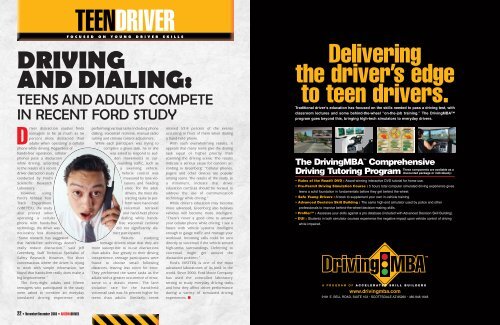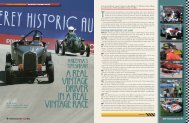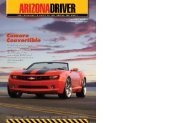Corvette's 50th Anniversary Corvette's 50th Anniversary
Corvette's 50th Anniversary Corvette's 50th Anniversary
Corvette's 50th Anniversary Corvette's 50th Anniversary
Create successful ePaper yourself
Turn your PDF publications into a flip-book with our unique Google optimized e-Paper software.
Driver distraction studies finds<br />
teenagers to be as much as 56<br />
percent more distracted than<br />
adults when operating a cellular<br />
phone while driving. Regardless of<br />
hands-free operation, cellular<br />
phones pose a distraction<br />
while driving, according<br />
to the results of a recent<br />
driver distraction study<br />
conducted by Ford’s<br />
Scientific Research<br />
Laboratory.<br />
However, using<br />
Ford’s VIRtual Test<br />
Track EXperiment<br />
(VIRTTEX), the study<br />
also proved when<br />
operating a cellular<br />
phone with hands-free<br />
technology, the driver was<br />
noticeably less distracted.<br />
“Some research has suggested<br />
that hands-free technology doesn’t<br />
really reduce distraction,” said Jeff<br />
Greenberg, Staff Technical Specialist of<br />
Safety Research. However, “for short<br />
conversations where the driver is trying<br />
to work with simple information, we<br />
found that hands-free really does make a<br />
big improvement.”<br />
The forty-eight adults and fifteen<br />
teenagers who participated in the study<br />
were asked to combine an everyday<br />
simulated driving experience with<br />
22 • November/December 2003 • ARIZONADRIVER<br />
TEENDRIVER<br />
FOCUSED ON YOUNG DRIVER SKILLS<br />
DRIVING<br />
AND DIALING:<br />
TEENS AND ADULTS COMPETE<br />
IN RECENT FORD STUDY<br />
performing various tasks including phone<br />
dialing, voicemail retrieval, manual radio<br />
tuning and climate control adjustment.<br />
While each participant was trying to<br />
complete a given task, he or she<br />
was asked to respond to sudden<br />
movements in surrounding<br />
traffic, such as<br />
a swerving vehicle.<br />
Vehicle control was<br />
measured by lane violations<br />
and heading<br />
error. For the adult<br />
drivers, the most distracting<br />
tasks to perform<br />
were hand-held<br />
voicemail retrieval<br />
and hand-held phone<br />
dialing while handsfree<br />
voicemail retrieval<br />
did not significantly distract<br />
participants.<br />
Results studying<br />
teenage drivers show that they are<br />
more susceptible to in-car distractions<br />
than adults. Due greatly to their driving<br />
inexperience, teenage participants were<br />
found to choose small following<br />
distances, leaving less room for error.<br />
They performed the same tasks as the<br />
adults with a greater occurrence of error;<br />
some to a drastic extent. The lane<br />
violation rate for the hand-held<br />
voicemail task was 56 percent higher for<br />
teens than adults. Similarly, teens<br />
missed 53.8 percent of the events<br />
occurring in front of them when dialing<br />
a hand-held phone.<br />
With such overwhelming results, it<br />
appears that many teens give the dialing<br />
task equal or higher priority than<br />
scanning the driving scene. The results<br />
indicate a serious cause for concern according<br />
to Greenberg: “Cellular phones,<br />
pagers and other devices are popular<br />
among teens. The results of the study, at<br />
a minimum, indicate that driver<br />
education curricula should be revised to<br />
address the use of communication<br />
technology while driving.”<br />
While driver’s education may become<br />
more advanced, Greenberg also believes<br />
vehicles will become more intelligent.<br />
“There’s never a good time to answer<br />
your cellular phone while driving. I see a<br />
future with vehicle systems intelligent<br />
enough to gauge traffic and manage your<br />
workload. Incoming calls could be sent<br />
directly to voicemail if the vehicle sensed<br />
high-stress surroundings. Deferring to<br />
voicemail might get around the<br />
distraction problem.”<br />
Ford’s VIRTTEX is one of the most<br />
advanced laboratories of its kind in the<br />
world. Since 2000, Ford Motor Company<br />
has used the controlled laboratory<br />
setting to study everyday driving tasks<br />
and how they affect driver performance<br />
during a variety of simulated driving<br />
experiences. ■<br />
Delivering<br />
the driver’s edge<br />
to teen drivers.<br />
Traditional driver’s education has focused on the skills needed to pass a driving test, with<br />
classroom lectures and some behind-the-wheel “on-the-job training.” The DrivingMBA<br />
program goes beyond this, bringing high-tech simulators to everyday drivers.<br />
The DrivingMBA <br />
Comprehensive<br />
Driving Tutoring Program<br />
These components are available as a<br />
discounted package or individually:<br />
• Rules of the Road® DVD : Award-winning interactive DVD tutorial for home use.<br />
• Pre-Permit Driving Simulation Course : 5 hours total computer simulated driving experience gives<br />
teens a solid foundation in fundamentals before they get behind the wheel.<br />
• Safe Young Drivers : A book to supplement your own in-vehicle training.<br />
• Advanced Decision Skill Building : The same high-end simulator used by police and other<br />
professionals to improve behind-the-wheel decision-making skills.<br />
• Profiler : Assesses your skills against a pro database (included with Advanced Decision Skill Building).<br />
•DUI: Students in both simulator courses experience the negative impact upon vehicle control of driving<br />
while impaired.<br />
www.drivingmba.com<br />
9181 E. BELL ROAD, SUITE 103 • SCOTTSDALE AZ 85260 • 480-948-1648





